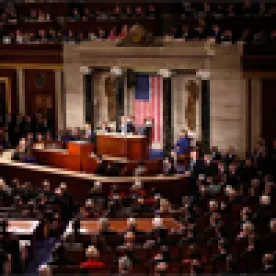In just five short weeks, the 115th Congress will convene in Washington. Now that Republicans control majorities in both houses and the White House, Republican leaders hope to use the Congressional Review Act (CRA) to overturn regulations issued by the Obama Administration over the past few months. According to a recent Congressional Research Service review, over 100 regulations are potential targets for Congressional disapproval under the CRA, including:
-
The Department of Labor’s new overtime rule requiring employers to pay overtime to employees making less than $47,000 per year
-
FDA regulations governing serving sizes and nutrition labeling
-
Department of Agriculture regulations on nutrition standards for food served in schools
-
Department of Health and Human Services regulations setting new performance standards for Head Start
-
EPA regulations setting standards of performance for municipal landfills
-
Treasury Department and Commodities Futures Trading Commission regulations governing covered swap entities, including margin and capital requirements
-
Department of Labor regulations requiring paid sick leave for federal contractors
-
Securities and Exchange Commission regulations requiring resource extraction issuers to disclose payments made to governments for the commercial development of oil, natural gas, or minerals
-
Department of Transportation/Federal Aviation Administration regulations regarding the use of small unmanned aircraft (“drones”).
The Congressional Review Act
The CRA provides expedited procedures by which Congress may disapprove an administrative “rule” by enacting a joint resolution of disapproval. A “rule” is broadly defined by reference to the Administrative Procedure Act and includes regulations issued by both executive branch departments and agencies (such as the Department of Labor), and independent agencies and commissions (such as the Federal Communications Commission or the Federal Trade Commission). Before a regulation can take effect, the issuing agency must report the regulation to Congress. After the report is made, Congress generally has 60 days to introduce and pass a joint resolution of disapproval under the CRA’s special procedures, but the counting of the 60 days differs depending on whether the joint resolution is being introduced or considered and whether consideration is taking place in the Senate or the House of Representatives.
When rules are submitted to Congress within 60 days of a sine die adjournment of Congress, such as at the end of the second session of a given Congress, then the 60 days clock “resets” at the beginning of the new session. Thus, for rules reported to Congress within 60 legislative days of the end of the 114th Congress, members of the 115th Congress will have the full 60 days to introduce and consider joint disapproval resolutions. The “reset” period begins on the 15th day of the new session. Because the CRA relies on legislative days—which are determined differently in each chamber—rather than calendar days, rules reported to Congress as early as mid-May 2016 may be eligible for congressional disapproval. The parliamentarian of each house determines the actual cutoff date for CRA disapproval of a given rule.
If a joint resolution of disapproval is timely enacted with respect to a particular regulation, then the regulation will not take effect — or, if the regulation already has gone into effect, it will be treated as if it had never gone into effect. Moreover, the regulation may not be reissued in substantially the same form, nor may a new regulation that is substantially the same be issued, unless it is specifically authorized by subsequently enacted legislation. The CRA may be used only to disapprove a regulation in its entirety, and the rejection of each given rule requires its own resolution of disapproval (although some members of Congress have proposed legislation that would permit Congress to disapprove of regulations in larger blocks).
The primary advantage of using the CRA to invalidate an undesirable regulation is its expedited procedures, particularly in the Senate. For example, if a joint resolution of disapproval is introduced in the Senate, and the jurisdictional committee fails to report it to the full Senate within a specified period, a petition of 30 senators may place the joint resolution on the Senate’s calendar. In addition, Senate consideration of the joint resolution is not subject to filibuster, and debate is limited. Once debate begins, the Senate may not move on to the consideration of other business until the joint resolution is disposed of. Enactment of a joint resolution of disapproval under the CRA requires a majority vote in each chamber of Congress and signature by the president.
The CRA has been used successfully only once. In November 2000, the outgoing Clinton administration issued final ergonomics regulations. In that same month, the Republican Party gained control of both chambers of Congress and the presidency. In March 2001, the Republican Congress used the procedures under the CRA to cancel the ergonomics regulations. The current political conditions are ripe for further such uses.
What’s Next?
President-Elect Trump campaigned on a promise to roll back countless Obama Administration regulations, and just last week proposed “formulat[ing] a rule that says that for every one new regulation, two old regulations must be eliminated.” Although repeal of most regulations would require new rounds of notice-and-comment rulemaking, Republicans who support undoing the previous administration’s rules may rush to end the 114th Congress early in order to maximize the number of existing or soon-to-take-effect rules subject to the CRA in the new Congress.
The new Republican Congress and the Trump Administration are also expected to use traditional legislation to rollback a number of Obama initiatives, including the Affordable Care Act (“Obamacare”) and its attendant regulations, dozens of Dodd-Frank Wall Street Reform and Consumer Protection Act regulations, the Department of Labor’s fiduciary rule for retirement plan advisors, and others. However, unlike regulations subject to the CRA, these rules are subject to filibuster by Senate Democrats.
The Republican leadership in both houses of the incoming 115th Congress are enthusiastic about rolling back Obama Administration rules and regulations, and have promised to use all tools at their disposal to accomplish that goal.
The strong likelihood that Congressional Republicans and President-Elect Trump will use the CRA to undo Obama Administration regulations should be of interest to companies who support or oppose the regulatory initiatives listed above, or any other regulations that may face Congressional scrutiny early in the new Congress.





 />i
/>i
